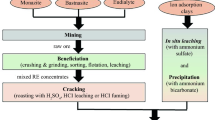Abstract
The k 0-method of standardisation for instrumental neutron activation analysis (INAA) has been used at the OPAL research reactor to determine the elemental composition of three certified reference materials: coal fly ash (SRM 1633b), brick clay (SRM 679) and Montana soil (SRM 2711). Of the 41 certified elements in the three materials, 88 percent were within five percent of the certified values and all determinations were within 15 percent of the certified values. The average difference between the measured and certified values was 0.1 percent, with a standard deviation of 4.1 percent. Since these reference materials are widely used as standards in the analysis of archaeological ceramics by INAA, it has been concluded that the INAA facility in Australia is particularly well-suited for nuclear archaeometry.




Similar content being viewed by others
Notes
http://www.kayzero.com/. Accessed February 2011
http://hlabsoft.com/. Accessed February 2011
References
Hancock RGV, Carter T (2010) J Archaeol Sci 37:243–250
Glascock MD, Neff H (2003) Meas Sci Technol 14:1516–1526
Bishop RL, Blackman MJ (2002) Acc Chem Res 35:603–610
Tsolakidou A, Kilikoglou V (2003) Comparative analysis of ancient ceramics by instrumental neutron activation analysis, inductively coupled plasma spectrometry and X-ray fluorescence analysis. In: 4th symposium on archaeometry. Hellenic Society for Archaeometry, Athens
Mommsen H, Beier T, Hein A (2002) J Archeol Sci 29:613–637
Knapp AB, Cherry J (1994) Provenience studies and bronze age cyprus: production exchange & politico-economic change. Prehistory Press, Madison
Hein A, Tsolakidou A, Iliopoulos I, Mommsen H, Buxeda i Garrigós J, Montana G, Kilikoglou V (2002) Analyst 127:542–553
Bennett JW (2008) J Radioanal Nucl Chem 278:671–673
De Corte F, Simonits A, De Wisperlaere A, Hoste J (1987) J Radioanal Nucl Chem 113:145–161
ISO (2005) ISO13528:2005(E), Statistical methods for use in proficiency testing by interlaboratory comparisons. Geneva, Switzerland
Acknowledgments
The authors would like to thank AINSE Ltd. for providing financial assistance through Research Award AINGRA 08098 to enable the analyses to be performed.
Author information
Authors and Affiliations
Corresponding author
Rights and permissions
About this article
Cite this article
Bennett, J.W., Grave, P. & Stopic, A. Establishing a basis for nuclear archaeometry in Australia using the 20 MW OPAL research reactor. J Radioanal Nucl Chem 291, 13–17 (2012). https://doi.org/10.1007/s10967-011-1267-8
Received:
Published:
Issue Date:
DOI: https://doi.org/10.1007/s10967-011-1267-8




